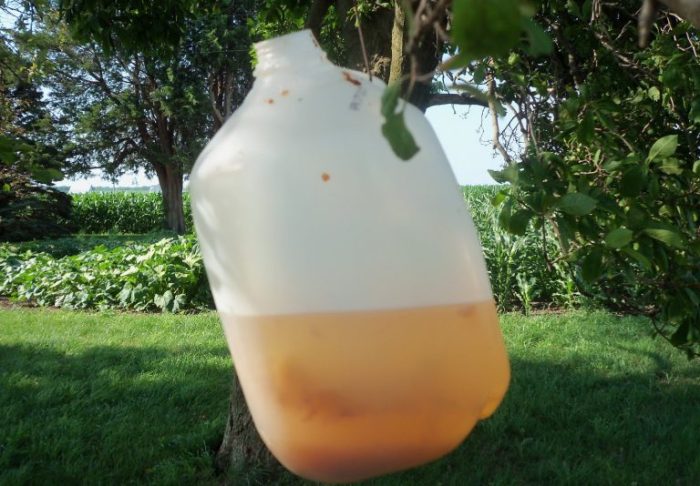Japanese beetle traps DIY are a popular and effective way to control these pesky insects in your garden. These traps work by attracting the beetles with pheromone lures or food-based baits, then trapping them in a container. Building your own traps can be a fun and rewarding project, and it can save you money compared to buying pre-made traps.
This guide will walk you through the process of designing, building, and maintaining your own Japanese beetle traps. We’ll cover everything from choosing the right materials to attracting the beetles and keeping your traps working effectively. Whether you’re a seasoned gardener or just starting out, this guide will equip you with the knowledge you need to create your own successful DIY Japanese beetle traps.
Environmental Impact and Sustainability: Japanese Beetle Traps Diy

While Japanese beetle traps can be effective in reducing beetle populations in your garden, it’s important to consider their environmental impact and the potential for unintended consequences.
Traps can attract and kill not only Japanese beetles but also other beneficial insects, such as pollinators and predators. This disruption of the natural ecosystem can have cascading effects on the health of your garden and the surrounding environment.
Impact on Beneficial Insects
Traps can indiscriminately capture and kill beneficial insects like ladybugs, lacewings, and hoverflies, which play a vital role in pest control and pollination. The loss of these beneficial insects can lead to an increase in other pests, potentially requiring more chemical interventions.
Impact on Bird Populations
Traps can also attract and kill birds that feed on insects, such as robins and sparrows. These birds rely on insects as a food source, and their populations can be negatively impacted by the widespread use of traps.
Sustainable Materials and Practices, Japanese beetle traps diy
When constructing DIY traps, consider using sustainable materials and practices to minimize your environmental footprint.
- Choose recyclable or biodegradable materials, such as cardboard, plastic containers, or natural fibers. Avoid using non-biodegradable materials like styrofoam or treated wood.
- Minimize the use of chemicals, such as pesticides or attractants. Opt for natural attractants like fruit or flower scents.
- Consider the placement of your traps to avoid attracting beneficial insects or harming wildlife.
Alternative Control Methods
There are alternative methods for controlling Japanese beetles that minimize environmental impact. These include:
- Handpicking: This method involves manually removing beetles from plants. It’s most effective for small infestations and can be a good option for gardeners who want to avoid using traps or chemicals.
- Using row covers: Row covers are lightweight fabric barriers that can be used to protect plants from beetles. They are effective at preventing beetles from laying eggs and feeding on plants.
- Encouraging natural predators: Attracting birds and other beneficial insects to your garden can help control Japanese beetle populations. This can be achieved by planting a variety of flowers and shrubs that provide food and shelter for these beneficial insects.
- Using biological control agents: These are naturally occurring organisms that can help control Japanese beetle populations. For example, milky spore disease is a naturally occurring fungus that can kill Japanese beetle larvae.
Resources and Further Information

This section provides a comprehensive guide to online resources, books, and organizations dedicated to Japanese beetle control and DIY trap construction. We’ll also explore relevant websites and articles offering insights into Japanese beetle biology, trapping techniques, and pest management strategies.
Online Resources and Websites
The internet offers a wealth of information on Japanese beetle control and DIY trap construction. These websites and articles provide valuable resources for understanding the pest, its life cycle, and effective management strategies.
- National Pest Management Association (NPMA): This organization offers a wealth of information on pest control, including Japanese beetles. Their website provides detailed articles on beetle biology, control methods, and DIY trap construction.
- University of Kentucky Entomology Department: The University of Kentucky Entomology Department has a comprehensive website dedicated to Japanese beetle control. It features detailed information on beetle biology, trapping techniques, and integrated pest management strategies.
- Penn State Extension: Penn State Extension offers a variety of resources on Japanese beetle control, including fact sheets, articles, and videos. Their website provides practical advice on trapping, chemical control, and cultural practices for managing Japanese beetle populations.
- Cornell University Integrated Pest Management: Cornell University’s Integrated Pest Management program offers a comprehensive approach to pest control, including Japanese beetles. Their website provides information on biological control, cultural practices, and chemical control options.
Books and Publications
Several books and publications offer detailed information on Japanese beetle control and DIY trap construction. These resources provide in-depth insights into the pest’s biology, behavior, and effective management strategies.
- “The Organic Gardener’s Handbook of Pest and Disease Control” by Barbara Pleasant: This comprehensive guide covers a wide range of pests and diseases, including Japanese beetles. It offers organic control methods, including trapping, cultural practices, and biological control.
- “The Complete Guide to Organic Gardening” by Rodale’s: This classic guide provides a wealth of information on organic gardening practices, including pest control. It offers detailed information on Japanese beetle biology, trapping techniques, and organic control methods.
- “The Gardener’s Bug Book” by Whitney Cranshaw: This book provides a comprehensive guide to common garden pests, including Japanese beetles. It offers detailed information on pest identification, biology, and control methods.
Organizations and Experts
Several organizations and experts specialize in Japanese beetle control and DIY trap construction. These resources can provide valuable advice, guidance, and support for managing Japanese beetle populations.
- The National Wildlife Federation: This organization promotes wildlife conservation and habitat protection. They offer information on managing Japanese beetle populations in a way that minimizes harm to beneficial insects and wildlife.
- Local Cooperative Extension Offices: Cooperative Extension offices in each state provide expert advice on a wide range of agricultural and horticultural topics, including pest control. They can offer guidance on Japanese beetle control strategies tailored to your specific location.
- Master Gardener Programs: Master Gardener programs are volunteer-based organizations that provide horticultural education and support to the public. They offer valuable advice on Japanese beetle control and other gardening topics.
Creating DIY Japanese beetle traps can be a satisfying and effective way to protect your garden from these destructive insects. By understanding the beetles’ behavior and using the right materials and techniques, you can design and build traps that are both efficient and environmentally friendly. Remember to monitor your traps regularly and adjust your strategy as needed. With a little effort and creativity, you can enjoy a healthy and beautiful garden free from the pesky Japanese beetle.
Homemade Japanese beetle traps are a great way to control these pesky insects, but you’ll need to consider the placement of the traps. If you’re dealing with a sloping yard, you might want to consider building some steps to make it easier to access the traps. There are plenty of DIY ideas for steps on a slope, like the ones you can find on this website.
Once you’ve got your steps in place, you can position your traps strategically to maximize their effectiveness.

